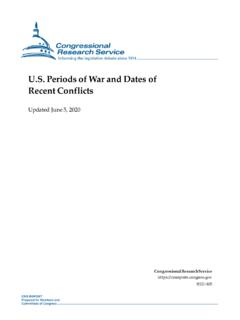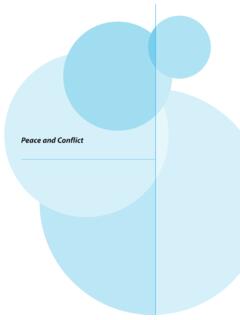Transcription of YEMEN: THE 60-YEAR WAR - Middle East Institute
1 YEMEN: THE 60-YEAR WARGERALD M. FEIERSTEINFEBRUARY 2019 POLICY PAPER 2019-2 CONTENTS* SUMMARY * 1 INTRODUCTION * 1 HISTORIC ANTECEDENTS * 4 A TALE OF FAILED TRANSITIONS: 1962- 90 * 9 POPULISM IN THE NORTH REFLECTED IN SIX SA DAH wars * 12 THE ARAB SPRING AND A NEW PUSH FOR NATIONAL UNITY * 17 REPEATED ATTEMPTS TO ADDRESS YEMEN S SYSTEMIC DIVISIONS* 20 EXTERNAL FACTORS IN THE CONFLICT * 25 CAN YEMEN S PROBLEMS BE SOLVED?* 27 CONCLUSION* 29 RECOMMENDATIONSSUMMARYThe root causes of the ongoing civil conflict in Yemen lie in the failure of Yemeni society to address and resolve the popular anger and frustration arising from political marginalization, economic disenfranchisement, and the effects of an extractive, corrupt, rentier state.
2 This systemic failure has produced a cycle of violence, political upheaval, and institutional collapse since the creation of the modern Yemeni state in the 1960s, of which the current conflict is only the latest the course of the conflict, Yemenis have come together repeatedly in an effort to identify solutions to these problems, and the result has been a fairly consistent formula for change: government decentralization and greater local autonomy, a federalized state structure, greater representation in parliament for disenfranchised populations, improved access to basic services, health and education, and a more even playing field for economic participation.
3 But none of these reform programs has been implemented successfully. Thus, success in ending Yemen s cycle of violence and its 60-YEAR civil war will depend on the political will to follow through on implementation and the development of institutional capacity to carry it out. The Middle East InstituteThe Middle East Institute1319 18th Street NWWashington, 20036 MAP OF YEMEN 1 INTRODUCTION Yemen s political transition, which began with much hope and optimism in 2011, collapsed by the fall of 2014 when Houthi insurgents occupied Sana a, the capital, with the support of forces loyal to former President Ali Abdullah Saleh. Intervention by a Saudi-led coalition of primarily Gulf Cooperation Council (GCC) member states in March 2015 turned the civil conflict into a broader war, attracting regional and international attention, although at its core this remains a civil war, not a proxy fight.
4 Neither side in the conflict has been able to gain a significant military advantage in the ensuing years while persistent efforts by the international community, under UN leadership, have also been unsuccessful in brokering a sustained return to negotiations and a resumption of the political analyses of the Yemen conflict since 2014-15 have focused on the issues and circumstances that led to the fighting in isolation from the larger problems that have long confronted Yemen. But, in my view, the current conflict is more accurately seen as a continuation of over 60 years of failed state formation leading to a cycle of violence, coups, assassinations, and open warfare.
5 The shotgun unification of North and South Yemen in 1990 only served to add a new layer of complexity to the already fraught political, social, and economic environment. If this perspective is correct, a resolution of the current conflict will only be a prelude to the next outbreak of violence. To avoid that outcome, Yemenis not only must agree on steps needed to build sustainable solutions to the country s problems but must also demand that their leaders implement ANTECEDENTSY emen bears all the hallmarks of a failed state as described by Daron Acemoglu and James Robinson in their landmark book, Why Nations The country suffers from an extractive political and economic system.
6 By definition, such systems are characterized by the concentration of power in the hands of a narrow elite and place few constraints on its exercise of power. As a general principle, Acemoglu and Robinson assert, extractive systems like Yemen s are vulnerable to violence, anarchy, and political upheaval and are unlikely to achieve growth or make major changes toward more inclusive institutions successfully. But the origins of the current conflict in Yemen go beyond even the consequences of the rentier state described by Acemoglu and Robinson. In fact, the political crisis that emerged in mid-2014 and metastasized into the current war is only the latest eruption in a cycle of violence that has shaken Yemen repeatedly for nearly 60 years.
7 Nor is it the MAP OF YEMEN TIMELINE 1962: Uprising against the Imamate in northern Yemen 1978: Beginning of Ali Abdullah Saleh s presidency of North Yemen and the Yemeni Socialist Party s rule in South Yemen 1990: Unification of North and South Yemen 1994: Civil war 2004-10: Six Sa dah wars 2011: Arab Spring and anti-Saleh uprising (February) End of Saleh presidency (November) 2013: National Dialogue Conference 2015: Houthi insurgents occupy Sana a 2 2(Earthstar Geographics | Esri, HERE, Garmin) 3 most violent or longest lasting of these There is no ten-year period in Yemen s history since the 1960s that has not witnessed violent conflict, coups, or civil insurrection.
8 Beginning with the 1962 uprising against the Zaydi Shi a theocracy, or Imamate, Yemenis have yet to find a means to build institutions of state and society that can address successfully the grievances of political and economic marginalization, and the alienation of populations disadvantaged by governing institutions and ethnic and sectarian discrimination. The unification of North and South Yemen in 1990 only added an extra layer of complexity to the country s problems. The failure to build the institutional structures of a modern, cohesive state, however, does not reflect an inability to understand the nature of the problems or devise reasonable solutions.
9 Yemenis have come together repeatedly in efforts to resolve their recurring challenges. Moreover, the efforts to find solutions have generally advocated similar reforms: decentralization and enhanced local autonomy, equal geographic representation in national government, federalism, and an equitable distribution of the country s natural resources. The most comprehensive effort followed the Arab Spring uprising against President Saleh s government in 2011. For over a year, more than 500 delegates labored to produce proposals to resolve persistent regional divisions within Yemen and the grievances of the Zaydi majority population of the northwestern highlands.
10 But, beyond that, the delegates to the most representative body of Yemenis ever assembled provided recommendations on a broad array of critical issues facing the country, including economics, governance, and the structure of military and security failure of state formation in Yemen, then, is not a result of the inability of Yemenis to understand the challenges, devise solutions, or create a road map for a unified state at peace with itself. The failure, instead, rests with the inability of Yemenis to implement the agreements reached. In at least two instances, in 1994 and in 2014, signed agreements were followed within weeks by a new outbreak of conflict.












